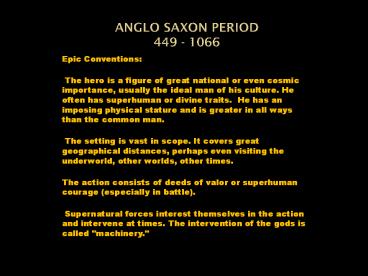Anglo Saxon Period 449 - 1066 - PowerPoint PPT Presentation
Title:
Anglo Saxon Period 449 - 1066
Description:
... Walter Raleigh To the Virgins to Make Much of Time by Robert Herrick To His Coy Mistress by Andrew Marvell STEP ONE: ... – PowerPoint PPT presentation
Number of Views:281
Avg rating:3.0/5.0
Title: Anglo Saxon Period 449 - 1066
1
Anglo Saxon Period449 - 1066
- Epic Conventions
- The hero is a figure of great national or even
cosmic importance, usually the ideal man of his
culture. He often has superhuman or divine
traits. He has an imposing physical stature and
is greater in all ways than the common man. - The setting is vast in scope. It covers great
geographical distances, perhaps even visiting the
underworld, other worlds, other times. - The action consists of deeds of valor or
superhuman courage (especially in battle). - Supernatural forces interest themselves in the
action and intervene at times. The intervention
of the gods is called "machinery."
2
BEOWULF AN EPIC HERO
The hero is a figure of great national or even
cosmic importance, usually the ideal man of his
culture. He often has superhuman or divine
traits. He has an imposing physical stature and
is greater in all ways than the common man. He
is mortal, overcomes all that get in his way of
achieving a goal, and can transcend
earth Written in Old English
3
Literary Characteristics of Anglo-Saxon period
- Alliteration
- Kenning
- Simile
- Caesura
4
THE ELEGY
- These poems are characterized by a tone of
longing and sadness - The Seafarer
- Wifes Lament
- The Wanderer
5
Medieval Period1066-1485
- Canterbury Tales
- By Chaucer
- Written in rhymed iambic pentameter, Chaucer
writes of the pilgrimage to the shrine of Saint
Thomas a Beckett
6
Canterbury Tales (cont)
- The prologue
- Set up the frame of the story
- Described the time of year the story took place
- Explained the contest
- Pardoners Tale Corruption of the church
- Wife of Bath What do women desire most?
7
Everyman
- Morality Play
- Allegory
8
Renaissance 1485-1660
- Protestant Reformation
- Henry VIII
- Recognition of corruption in the Catholic Church
9
Poetry of the Renaissance
- The widespread belief in personal ability and the
potential of the individual had its roots in
humanism - HUMANISM An intellectual movement in which
writers and artists sought to merge the lessons
of Latin and Greek classics with the teachings of
Christianity. - Poetic patterns combined with complex subject
matter
10
The Sonnet
- From the Italian meaning little song
- ALL sonnets have the following
- Iambic Pentameter
- Strict rhyme scheme
- 14 lines
- Lyric poem
11
The Sonnet (cont)
- Sonnet 30
- By Edmund Spencer
- My love is like to ice, and I to fire. . .
12
Metaphysical Poetry
- A Valediction Forbidding Mourning by John Donne
- Thy soul the fixed foot, makes no show /to move,
but doth, if th other do
13
Lyric Poetry
- On My First Son by
- Ben Jonson
- Rest in soft peace, and asked, say Here doth
lie /Ben Jonson his best piece of poetry
14
Paradise Lost by John Milton
- In medias res (in the middle)
- Literary Epic poem
- The speaker invokes the Muse or a divine being to
speak through the poet - Characterized by
- Epic similes (extended comparisons between
dissimilar things) - Allusion (references to biblical characters and
events, classical, mythological)
15
The Fall of Satan
16
Pastoral Poetry
- The Passionate Shepherd to his Love by
- Christopher Marlow
- The Nymphs Reply to the Shepherd by Sir Walter
Raleigh
17
Carpe Deim Poetry
- To the Virgins to Make Much of Time by Robert
Herrick - To His Coy Mistress by Andrew Marvell
18
STEPS IN THE PROCESS OF RESEARCH
- STEP ONE Prewriting and Planning
- A. Chose and limit your topic
- B. Identify sources that will be helpful
- Complete bibliography cards
- Evaluate sources
- C. Take notes
- Summarize, Paraphrase, Quote
- AVOID PLAGIARISM
19
Steps continued
- STEP TWO Prewriting Developing an Outline
- A. Develop and outline
- B. Develop a thesis statement
20
STEPS continued
- STEP THREE DRAFTING
- A. Write from an outline
- B. Manage information
- C. Draft Introduction and conclusion
21
Steps continued
- STEP FOUR CITING SOURCES
- A. Document information
- B. Format your citations
- C. Insert parenthetical documentation
- D. Create your Works Cited list
22
Steps continued
- STEP FIVE REVISING
- Revise the research paper
- Organization
- Word choice
- Paragraph support
- Introduction
- Transitions
- Conclusion
23
STEPS continued
- STEP SIX EDITING AND PRESENTING
- A. Use an editing checklist
- Words omitted?
- Typing errors?
- Punctuation correct?
- Proper nouns capitalized?
- Sources documented?
- Pagination?

